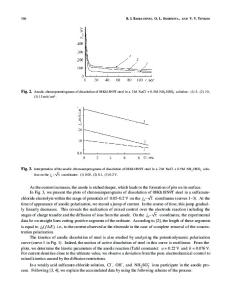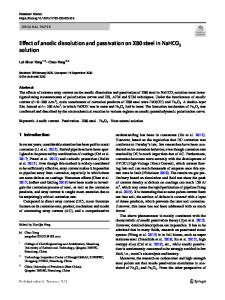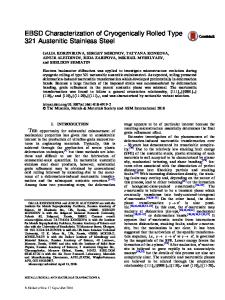Anodic dissolution of diamondlike carbon film-coated type 301 stainless steel
- PDF / 259,217 Bytes
- 9 Pages / 612 x 792 pts (letter) Page_size
- 22 Downloads / 271 Views
MATERIALS RESEARCH
Welcome
Comments
Help
Anodic dissolution of diamondlike carbon film-coated type 301 stainless steel C. Srividya, I. Moskowitz, and S. V. Babu Center for Advanced Materials Processing and Department of Chemical Engineering, Clarkson University, Potsdam, New York 13699 (Received 20 February 1998; accepted 23 December 1998)
The resistance of thin diamondlike carbon (DLC) films to anodic breakdown in aqueous electrolytes was investigated using voltammetry. The films were less than 0.5 mm thick and were deposited on type 301 stainless steel substrates using plasma-assisted chemical vapor deposition (PACVD) from either methane, acetylene, or 1,3-butadiene precursors with argon or hydrogen as diluent. A 10 nm thick polysilicon (PS) film was plasma-deposited prior to DLC film deposition to improve adhesion. The electrolytes used for corrosion testing were mixtures of 0.1 M NaCl and 0.1 M Na2 SO4 and 0.1 M HCl and 0.1 M Na2 SO4 in de-ionized water. The measured anodic current was lowest for the films deposited from butadiene and highest for those deposited from methane. The anodic current also increased with an increase in the hydrogen content in the feed gas mixture. In addition, the DLC films deposited at higher gas flow rates offered more resistance to anodic dissolution than those deposited at lower gas flow rates. Annealing improved the film performance. There appears to be an optimum DLC film thickness which provides the maximum resistance to anodic dissolution. In the best case, the DLC films reduced the anodic dissolution of bare stainless steel by about 4 orders of magnitude in the passive region. Atomic force microscopy studies of coated and uncoated stainless steel showed that the DLC films conformed to the steel substrate surface and had no effect on surface roughness, while DLC coated silicon substrates showed no evidence of pores.
I. INTRODUCTION
Diamond-like carbon films have a fascinating combination of properties. They are extremely hard, 3000– 9000 kgymm2 ,1 and very smooth. Friction coefficients in the literature range from 0.01 to 0.28.2 These films also have high wear resistance,3,4 as well as a wide range of electronic properties.1 This unusual combination of physical properties and the possibility of varying these properties in a controlled manner make DLC attractive for a wide range of technologies. DLC has been used as a protective optical coating for infrared devices and solar cells,5 as an anti-abrasion coating for VCR head drums and magnetic recording disk sliders,5 and it is a prospective candidate for various biomedical applications.5 One of the reasons that DLC is such a promising choice for all of these applications is that in addition to its other characteristics, DLC is also resistant to chemical attack and can provide an effective barrier layer against corrosion, as will be shown here. Kwiatek et al.6 conducted electrochemical impedance spectroscopy measurements of partially amorphous carbon films that were deposited cathodically. These films, however, proved to b
Data Loading...











